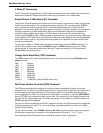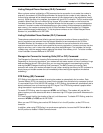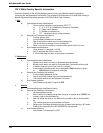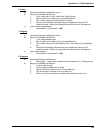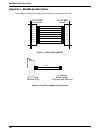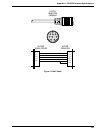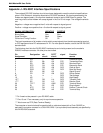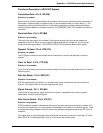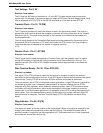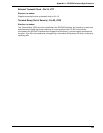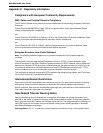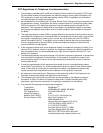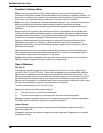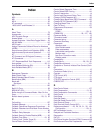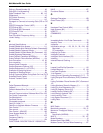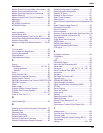
158
MultiModemBA User Guide
Test Voltage - Pin 9, XV
Direction: from modem
The XV lead has 330 ohms of resistance to +12 volts DC. This lead may be used to strap other
signals high. For example, if the terminal does not supply a DTR (Data Terminal Ready) signal, Pin 9
may be jumpered to Pin 20 (DTR) on the RS-232 connector or in the cable to force DTR on.
Transmit Clock - Pin 15, TC (DB)
Direction: from modem
The TC signal is provided only when the modem is used in the synchronous mode. The clock is a
square wave and is used to provide the computer or terminal with timing information for its Transmit
Data circuit (pin 2). This clock will be provided on the interface at all times when the modem is in
Synchronous mode.
The first signal element of the Transmitted Data signal should be presented by the terminal on the
first positive (Off to On) transition of TC which occurs after the CTS circuit on pin 5 has turned on.
The transmitted data is sampled by the modem on negative transition
of TC.
Receive Clock - Pin 17, RC (DD)
Direction: from modem
The RC signal has the same characteristic of Transmit Clock, with the exception that it is used to
provide the computer or terminal with timing information for its Receive Data (pin 3) circuit. The
negative transition (On to Off) of RC indicates the center of each signal element on the Received
Data circuit.
Data Terminal Ready - Pin 20, TR or DTR (CD)
Direction: to modem
This signal (TR or DTR) provides a means for the terminal or computer to control the modem's
connection to the communications channel. A high DTR signal is required by the modem to be able to
communicate. Turning DTR off for more than 50 mSec will force the modem to disconnect.
The most common use of DTR is in automatic answer applications. A high DTR signal is required by
the modem to answer a call. A frequently used method is to have the computer turn on DTR in
response to RI (Ring Indicator), which allows the modem to answer. Later, DTR is turned off at the
conclusion of the log off procedure, which forces the modem to disconnect, enabling it to receive
another call. In non auto answer applications it is advisable to leave DTR on using the modem's DIP-
switch option. This is the standard factory setting. An alternative is to provide a constant high DTR
from the terminal or computer. The Data Terminal Ready (DTR) LED indicates the status of this
signal.
Ring Indicator - Pin 22, RI (CE)
Direction: from modem
This signal will remain on for the duration of the ringing signal. When a ring signal is received by the
modem, the modem will automatically answer after the first ring. The modem will answer after a
specified number of rings which can be programmed in AT Command mode, but if none is specified,
the modem will answer after the first ring.



